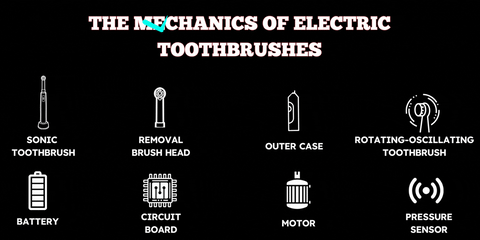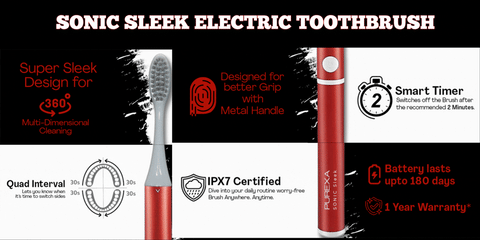Contrary to the popular opinion that manual toothbrushes are gentler on your teeth, electric toothbrushes police the bacteria out of your mouth without being harsh on your buccal cavity.
Electric toothbrushes can be decidedly pronounced as the new oil of oral health.
Researchers have found that individuals who use an electric toothbrush have improved gum health, reduced tooth decay, and retained their teeth for longer than those who opt for a manual toothbrush. A solvent in its own right, an electric toothbrush can remove up to 21% more plaque than a manual toothbrush.
While facts and figures doll up an otherwise flat case for electric toothbrushes, the science behind their functionality often goes untold. In this blog, we explore how electric toothbrushes have found themselves a red carpet in the world of oral health, making purposeful strides into the bathroom vanity of every hygienist.
So tag along as we sink into the specifics!
The Mechanics of Electric Toothbrushes

All the pretty surveys aside, how do electric toothbrushes score a 10 on the efficiency scale? The answer is a culmination of multiple variables- from the sturdy build to the smart technology that powers its various movements, electric toothbrushes make oral hygiene a simple exercise to practice and preach.
To understand how an electric toothbrush works, let’s first understand the different parts that come together to make it an effective whole.
1. Outer case– The outer case of an electric toothbrush clads the machinery inside. Attached onto it are the on/off button and battery life indicator. The shell works to protect the electric nitty gritties of the tool such as the battery and circuit board, which need to be kept at a safe distance from water.
2. Motor– The motor of an electric toothbrush cranks to life when the power is switched on. The motor will begin to spin once it receives energy through the circuit board and orients the brush head to produce a brushing motion. The cam and gear system with the motor can move in different directions, like a manual toothbrush. If your electric toothbrush has different modes, you can choose how it moves.
3. Battery– Electric toothbrushes operate thanks to their power source, usually an internal rechargeable battery. This battery provides the energy needed to spin the electric motor inside the brush, effectively cleaning your teeth.
The battery life can differ depending on the toothbrush model and the chosen cleaning mode, with some modes draining the juice faster than others. Many electric toothbrushes utilise rechargeable batteries, which can be recharged using an inductive charger. Alternatively, some models use replaceable batteries, allowing you to swap out old ones for new ones when needed.
4. Circuit Board– When you activate your electric toothbrush or select a specific mode, you're essentially flipping a switch on the circuit board. These switches instruct the motor on how to operate.
Additionally, circuit boards can display battery status or chosen cleaning mode using LED lights. However, not all toothbrush models have these features; it depends on the specific make and model of your electric toothbrush.
5. Pressure Sensor– Certain toothbrushes include pressure sensors to help monitor your oral health. While brushing, feedback is transmitted through the brush.
The pressure sensor activates if excessive pressure is applied to the teeth, often indicated by an LED light. When pressure is reduced, the light turns off and the sensor deactivates.
6. Removable Brush Head– Nearly every electric toothbrush comes with a detachable brush head. This is because the bristles on the head wear out over time, reducing their effectiveness in cleaning your teeth and mouth.
Each brand of electric toothbrush has its own unique brush head design, and it's important to regularly replace these.
Electric toothbrushes effectively clean teeth by employing various rotational movements. They help remove plaque and reduce gingivitis by gently stimulating the gums.
These toothbrushes are particularly beneficial for individuals with limited mobility, as they significantly slash the effort required for thorough cleaning. While users still need to guide the brush, the majority of the cleaning work is done by the brush head itself.
So with mechanics behind us, let’s move on to the next discussion that’s elbowed its way into today’s blog. What are the different types of electric toothbrushes available on the market?
Sonic Toothbrush- A sonic toothbrush is an electric brush that vibrates rapidly to remove plaque and clean teeth thoroughly. Operating at speeds of 24,000 to 40,000 strokes per minute, it reaches outback areas and stimulates fluid flow between teeth and gums. This technology can help prevent conditions like periodontitis. While users may initially feel a tickling sensation, sonic toothbrushes offer superior oral hygiene benefits due to their increased speed and fluid dynamics.
Rotating-Oscillating Toothbrush- Rotating-oscillating electric toothbrushes move back and forth, reaching speeds of up to 8,800 strokes per minute. Their rotating heads clean teeth precisely without applying too much pressure.
The market is flooded with both types of electric toothbrushes, each offering its unique set of features that prop up your dental hygiene.
Sonic brushes are user-friendly while rotating brushes require more pressure and patience. There is no conclusive study that indicates which type is better. It depends on your unique user case.
Electric toothbrushes excel at removing plaque by oscillating or rotating at higher speeds, making them particularly beneficial for individuals struggling with plaque removal or prone to gum disease. They combat gum inflammation by removing plaque and promoting healthier gums through improved circulation and massage action.
Also Read - How to use an electric toothbrush?
Choosing the right electric toothbrush

When selecting an electric toothbrush, you may want to consider the following factors:
Brushing Modes– Look for toothbrushes with various modes like sensitivity, whitening, gum care, and deep cleaning to cater to your oral health needs.
Bristles– Opt for soft bristles recommended by dental professionals for gentle care of your teeth and gums.
Battery Life– Choose a toothbrush with a long-lasting battery, ideally lasting at least a week for convenience.
Size– Ensure the toothbrush size suits your needs and is compatible with your teeth.
Additionally, you should also probe a prospective product for
- Motor power
- Two-minute timer
- Affordable refill options
- Compatibility with a range of replacement brush heads.
Final Thoughts
Much against what you’ve been told and retold, an electric toothbrush doesn’t occupy a generous room on your budget. It’s a cost-effective investment that pays off in the long haul with sparkly smiles and healthy gums.
Having reservations and feeling reluctant to switch to a new mode of brushing is normal. Incorporating different equipment into a day-to-day activity, even if it enhances our experience of performing it, can feel like an excess. Studying the features, mechanics, and benefits of an electric toothbrush can help you make a wise choice. Talking to a dental professional can further help you make up your mind about the type of toothbrush that best suits your lifestyle.
With multiple cleaning modes, effective plaque removal, and built-in timers that facilitate your brushing experience, electric toothbrushes have come a long way from being a fancy first to a standard directive from dental care experts.

PUREXA Electric toothbrushes offer a superior clean with high-frequency sonic vibrations for gentle yet effective plaque removal. Designed for comfort and convenience, each brush boasts a sleek, lightweight design and a long-lasting battery life. With smart features like a 2-minute timer, our brushes ensure you get the dentist-recommended clean every time.
Written by Dr. Shipra Jaiswal, BDS, MDS, a Periodontist and Gums Specialist